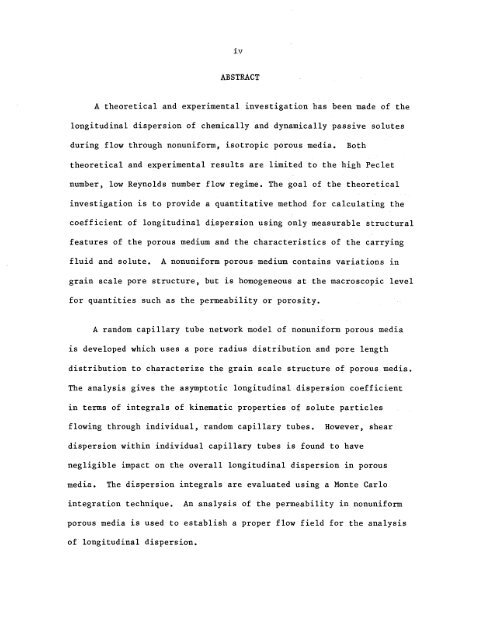longitudinal dispersion in nonuniform isotropic porous media
longitudinal dispersion in nonuniform isotropic porous media
longitudinal dispersion in nonuniform isotropic porous media
Create successful ePaper yourself
Turn your PDF publications into a flip-book with our unique Google optimized e-Paper software.
iv<br />
ABSTRACT<br />
A theoretical and experimental <strong>in</strong>vestigation has been made of the<br />
<strong>longitud<strong>in</strong>al</strong> <strong>dispersion</strong> of chemically and dynamically passive solutes<br />
dur<strong>in</strong>g flow through <strong>nonuniform</strong>, <strong>isotropic</strong> <strong>porous</strong> <strong>media</strong>. Both<br />
theoretical and experimental results are limited to the high Pee let<br />
number, low Reynolds number flow regime. The goal of the theoretical<br />
<strong>in</strong>vestigation is to provide a quantitative method for calculat<strong>in</strong>g the<br />
coefficient of <strong>longitud<strong>in</strong>al</strong> <strong>dispersion</strong> us<strong>in</strong>g only measurable structural<br />
features of the <strong>porous</strong> medium and the characteristics of the carry<strong>in</strong>g<br />
fluid and solute. A <strong>nonuniform</strong> <strong>porous</strong> medium conta<strong>in</strong>s variations Ln<br />
gra<strong>in</strong> scale pore structure, but is homogeneous at the macroscopic level<br />
for quantities such as the permeability or porosity.<br />
A random capillary tube network model of <strong>nonuniform</strong> <strong>porous</strong> <strong>media</strong><br />
is developed which uses a pore radius distribution and pore length<br />
distribution to characterize the gra<strong>in</strong> scale structure of <strong>porous</strong> <strong>media</strong>.<br />
The analysis gives the asymptotic <strong>longitud<strong>in</strong>al</strong> <strong>dispersion</strong> coefficient<br />
<strong>in</strong> terms of <strong>in</strong>tegrals of k<strong>in</strong>ematic properties of solute particles<br />
flow<strong>in</strong>g through <strong>in</strong>dividual, random capillary tubes. However, shear<br />
<strong>dispersion</strong> with<strong>in</strong> <strong>in</strong>dividual capillary tubes is found to have<br />
negligible impact on the overall <strong>longitud<strong>in</strong>al</strong> <strong>dispersion</strong> <strong>in</strong> <strong>porous</strong><br />
<strong>media</strong>. The <strong>dispersion</strong> <strong>in</strong>tegrals are evaluated us<strong>in</strong>g a Monte Carlo<br />
<strong>in</strong>tegration technique. An analysis of the permeability <strong>in</strong> <strong>nonuniform</strong><br />
<strong>porous</strong> <strong>media</strong> is used to establish a proper flow field for the analysis<br />
of <strong>longitud<strong>in</strong>al</strong> <strong>dispersion</strong>.

















